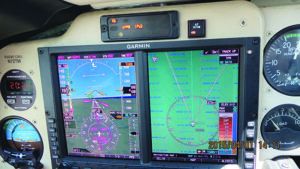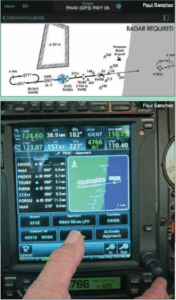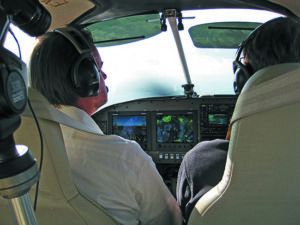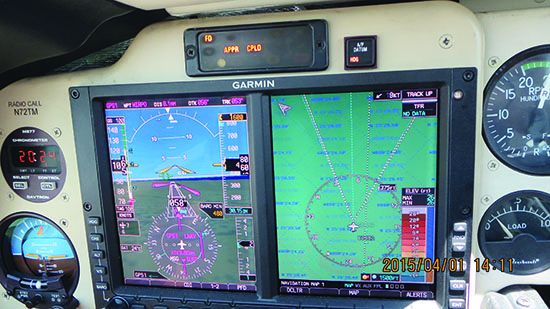As time marches on, so do advancements to many of the aircraft we are fortunate enough to fly. When I did my initial instrument training, I remember the high-workload events like setting up and briefing approaches, talking to ATC and running the checklists, all while hand-flying the aircraft on steam gauges. It was an exercise in managing task saturation, and it was easy to get behind if one was not on the ball. My instructor used to say, “If you are not doing something, you are missing something.”
When I transitioned to professional flying, it is somewhat ironic how all the procedures and techniques I used for single-pilot IFR during my instrument training fly completely in the face of modern CRM recommendations and SOPs. If a pilot is hand-flying, that is all they are focused on. For passenger-carrying operations, it is not even legal to dispatch a single pilot without a functioning autopilot. When implemented appropriately and functioning correctly, automation can reduce pilot workload and keep the crew in front of the airplane.
KNOWLEDGE IS POWER
Before even attempting a coupled approach, a pilot should have a firm understanding of their autopilot and its functionality. I have flown aircraft with a basic two-axis autopilot that was capable of holding altitude and heading but could not track a needle with any reliability. More-modern aircraft may have three-axis autopilots that can keep it squarely in flight-director parameters with impressive precision. Something to consider is that some autopilots have minimum-altitude limits affecting said capability. For example, the PC-12NG allows autopilot use until 200 feet agl on precision approaches and 400 feet agl for non-precision approaches. If such limitations do not exist for the aircraft you fly, you will have to use your best judgment.
Another consideration is how different aircraft have managed to integrate GPS navigation into their avionics. For example, the Citations I fly cannot track the glidepath of an LPV approach in the same way they can track an ILS glideslope. Instead of selecting approach mode in the autopilot controller, the procedure requires remaining in NAV mode and selecting VNAV, prompting the autopilot to follow the vertical path. With their varying levels of complexity, it is impossible to cover all types of autopilots and their ability to fly approaches, but consulting your AFM or supplementary avionics manuals is the first step to reducing confusion. If there is still any confusion, ask your favorite instructor or a mentor pilot.

The Flight Mode Annunciator (or scoreboard, as I like to call it) is typically found along the top of the PFDs (Primary Flight Displays). It delineates the active mode of the automation, as well as any modes that may be armed. One of the primary roles of automation management is, well, managing the automation. This is your snapshot, right at the top of your scan, of what you set the autopilot to do. It is essential to keep this in your scan. Additionally, it is the habit of a good automation manager to check the scoreboard whenever a change occurs or an action is requested of the automation. For example, if one sequences the approach but forgets to select APR mode, it will be caught by a proper scan of the Flight Mode Annunciator. On many PFDs, it should also indicate when a new course has been captured, such as a localizer or glideslope.
You may be operating an aircraft without glass gauges and still be capable of coupled approaches. This advice still stands, but the scan may be a bit more awkward. My experience with this was a Piper Aztec, where I had to adjust my scan to include the area in front of my left knee whenever I made any changes to the automation.
SETTING IT UP
The first critical step to ensuring a coupled approach is flown properly is setting up the panel for the procedure. Make sure everything is sequenced and briefed, even if operating single-pilot. A lot of good habits from hand-flying transfer over to this. For example, I found that successful instrument pilots have a plan at the final approach fix (FAF). Most pilots aim to be done with checklists and configured and, as they cross the FAF, they pitch down and reduce power. This same idea can be brought to a coupled approach.
The autopilot should be capturing the glideslope, or whatever pitch mode was briefed for the approach. One of the most common mistakes I see is the pilot forgets to select the appropriate autopilot sub mode for the approach, and instead of intercepting the glide path, the aircraft continues happily along at altitude. Now the aircraft is above glide, and the temptation exists to chase the glide path down and recover. This almost always causes an unstabilized approach.
FAILURES
If to err is human, to fail is mechanical. If you fly enough coupled approaches, eventually you will experience an autopilot failure. They range from benign, such as an uncommanded disconnect, to severe, like a trim runaway. Most autopilots are reliable enough that pilots are comfortable removing their hands from the controls. For long periods of higher-altitude cruise flight, this is probably fine. When shooting an approach, slow and close to the ground, it is prudent to keep your hands on the controls ready to take over. Any trim or autopilot malfunctions should be treated as memory items and practiced.
Additionally, knowing what other failures affect the autopilot is helpful. Every aircraft is different. If you have a glass cockpit, know what an ADHRS or screen failure will do to the automation on a coupled approach. In the different planes I have flown, I have seen many different outcomes. Sometimes the autopilot disconnects, but the flight director is still tracking appropriately. In one aircraft I have flown, the autopilot remains on, but the sub modes revert to pitch and roll capability only, meaning that neither the vertical nor lateral navigation is being tracked.
If I have some sort of autopilot failure prior to the FAF, I will request delay vectors until I know it is sorted out or I have changed my plan, to include hand-flying. Beyond the FAF, it does become a judgment call. I worked with a crew who had a nightmare situation come true, where they were about 100 feet from minimums with the autopilot on and they had a pitch trim runaway, where the nose was being forced down. Due to the crew’s quick action, they were able to interrupt the trim and land safely. They had the runway in sight and felt it was a safer decision to land immediately rather than go missed with a flight control malfunction. Your mileage may vary. If there is any doubt a safe landing can be made, a missed approach should be initiated.

Flying coupled non-precision approaches presents some unique risks. The FAA has been pushing CDFA (or constant-descent final approach) to the MDA, particularly on approaches with a visual descent point or glideslope. This is great method to ensure a stabilized approach, but it can be situation dependent. A Cessna 152 landing on a 5000-foot runway may be able to level off at the MDA for a while and eventually make a safe descent to land. A CJ3 might not. Additionally, many aircraft do not generate said glide path; it is either up to the pilot to make one or determine another suitable method of transitioning from the FAF to MDA.
One of most common checkride failures I have witnessed involve flying a coupled non-precision approach. The crew very effectively monitors the automation, keeping a perfect speed in the descent. The SOP for that aircraft was to use VS mode, which meant the autopilot was flying a selected vertical speed in feet per minute. Crews would select 800 fpm, and set the altitude preselect to the MDA. It is easy to forget certain aspects of flying when the plane is doing most of the work, and that is exactly what would happen. The aircraft would level off at MDA and the crew would fail to add power, distracted by either looking for lights or initiating a circle, depending on the approach. Low, slow and fully configured, the aircraft quickly approached a stall. Unless the aircraft you fly has auto throttles, even a three-axis autopilot needs some help leveling off.
BREAKING OUT
Another challenge presented with coupled approaches involves breaking out, taking control of the airplane and continuing to land. It can be a challenging transition, especially in low visibility or crosswinds. When inexperienced automation managers first disconnect the autopilot in a crosswind, for example, their desire is to align the aircraft with the runway. The autopilot was flying a perfect crab and when one removes that crab, the aircraft will now be well off centerline. Now the pilot must correct the crab and realign the aircraft. If the autopilot is working correctly, there is no rush to correct any inputs when it is disconnected. In fact, the aircraft should be trimmed perfectly.
When breaking out in low visibility, the transition from monitoring the autopilot to hand-flying can be very disorienting. I brief this with pilots who have never experienced landing with an 1800-foot RVR. The bright approach lights can be nearly blinding after being socked in for the whole approach. When breaking out and disconnecting the autopilot, it is critical to remain partially inside, at least until transitioning to land. I have seen pilots level off at the decision altitude (DA) and reenter IMC, prompting a missed approach. I have also seen the opposite, where pilots lose the glideslope completely and end up diving for the newly discovered ground. If you keep your scan moving, half inside/half outside, you can stay on profile and maintain the nice stable approach the autopilot hopefully set you up on.
MAINTAINING PROFICIENCY
When I am conducting training events, I always have my crews fly at least one “raw-data” approach, which is conducted with no autopilot and no flight director. It is often considered one of the more challenging maneuvers. In every airplane I have flown, there is a failure that exists that will wipe the automation down to nothing. It can be surprising to see professional pilots with thousands of hours struggle to fly an approach without automation. They even have a pilot monitoring that can call out deviations for them if they so choose. Sometimes I will remind the applicants that they were once capable and very proficient at flying approaches raw-data, having demonstrated several approaches to minimums for a DPE likely with no autopilot at all for their instrument rating.
The trick is practice. The irony is not lost on me that I am writing an article about coupled approaches and I am recommending practicing hand-flying approaches. If your mission involves an advanced, automated aircraft and IFR operations, it is prudent to ensure hand-flying skills are not atrophied. The automation can (and probably will) eventually fail and the approach will have to be flown the old-fashioned way. Practicing on days where the weather is not down to minimums is a great way to minimize this threat.

Flying a coupled approach, when the autopilot is functioning and set up correctly, allows the pilot to focus on flying a stabilized approach. The instrument scan should be just as diligent, but not having to make constant small corrections frees up mental bandwidth. In single-pilot operations, where shooting an approach to minimums means dividing attention inside and outside the cockpit while approaching the DH, DA or MDA, it can make all the difference. Like most great tools that help increase safety, over-using them may mean other skills atrophy.
FINAL THOUGHTS
Automation is a wonderful tool that has increased safety across the board, especially when flying advanced aircraft or for folks out there operating single-pilot in IFR situations. None of the airplanes I am currently paid to fly are even allowed to be dispatched IFR with an inoperative autopilot, which shows how much the manufacturers value the safety buffer that automation adds. Like any tool, it is essential that it’s used correctly.
I once heard a valuable piece of advice about automation management, that it is a good idea to treat the autopilot like a crew member. A crew member who is a great stick and very obedient, but very dumb. If you tell the autopilot to fly a 500-fpm descent, it will, and probably right into the ground. Make sure you keep an eye on your crew member and be ready for them to occasionally quit on you. But if you make sure you are giving them the right commands, you will have a tremendous asset in your cockpit, especially when shooting approaches.
Ryan Motte is a Massachusetts-based Part 135 pilot, flight instructor and check airman. He moonlights as Director of Safety when he isn’t flying.




